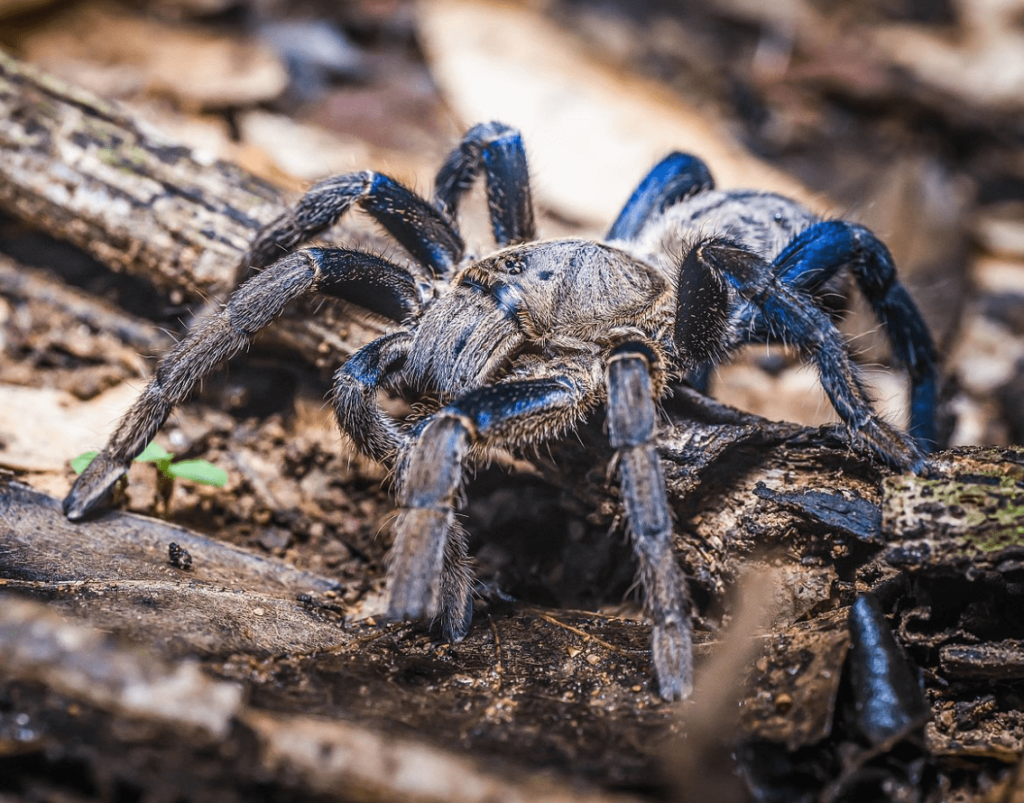Beautiful Blue Cobalt Tarantula It is native to Thailand, Burma, and the tropical rainforests of Myanmar. They are popular pets. Because it has a bright blue color Tarantula fans find them attractive, however, they are one of the most protective and unpredictable species. These tarantulas can be quick to defend themselves and are voracious diggers. Therefore, it is not recommended for inexperienced operators. Fortunately, the cobalt blue tarantula’s venom is not fatal to humans. Although it can cause extreme discomfort. These tarantulas are quick to bite and do not like to be handled or touched, even by children.
Table of Contents
Blue Cobalt Tarantula Scientific Name

Cyriopagopus lividus is the scientific name for a cobalt blue tarantula in the family Theraphosidae. This includes tarantulas or large hairy spiders. Southeast Asian tarantulas, which can be found from Burma to the Philippines, belong to the genus Cyriopagopus.
Blue Cobalt Tarantula Appearance
A medium sized tarantula known for its blue legs and light gray body and dark gray chevron pattern is called a cobalt blue tarantula. Females are slightly larger than males. It has a leg length of about five inches. When viewed from a distance This spider looks dark. But if you look closely, it appears a dazzling blue.
From some research studies Blue Cobalt Tarantula can sense different colors. And they use bright colors to communicate, find mates, and hide from danger.
Although males and females look similar, But in the final molting process, they show sexual differences. Males develop mating hooks and turn copper after their final molt. During the last molt Females are larger than males and live longer.
Blue Cobalt Tarantula Temperament
Cobalt blue tarantula Although it tends to change shape easily and is protective. But it is very much in demand as a pet. These stressed animals do not perform well during housekeeping or habitat maintenance procedures. And they don’t like being caught. Cobalt blue tarantulas are more erratic than other species. and easily attacks when they feel threatened When handled, small tarantulas will bite.
In addition to being agile The cobalt blue tarantula also has a powerful venom. Biting causes inflammation. muscle pain and feel a burning sensation But not enough to harm a person. A tarantula bite can cause a severe allergic reaction in some people.
Blue Cobalt Tarantula Habitat
This tarantula is found in the tropical rainforests of Southeast Asia in the wild. They are found in countries such as Vietnam, Burma, Thailand, Laos and Cambodia. There is pressure on this species in the natural environment due to deforestation and hunting for the pet trade.
Because it is a fossil species So they live underground in tunnels that they make themselves. Cobalt blue tarantula even in captivity But they spend most of their time in burrows and emerge only to search for food.
This species requires warm temperatures, ranging from 77 to 85 degrees Fahrenheit. and has high humidity for digging Pet tarantulas need a large tank and a sufficiently moist surface. The larger the tank, the The less likely you are to get in and out of the cage.
Blue Cobalt Tarantula Diet
It is possible that your cobalt blue pet will only emerge from its burrow at feeding time. This is because these tarantulas grow quickly. So the appetite is great.
They like to wait for prey to cross their path by staying close to the edge of their burrow. After eating the food, they take it back into the cave and eat it whenever they want.
Cobalt blue tarantulas are advised to eat mealworms, cockroaches, mouse pups, and crickets. Please think carefully before giving any outside items to your pet. This is because it may contain insecticides and parasites.
This is to avoid damaging the cobalt blue during the molting process. It is recommended not to feed it.
Cobalt blue tarantulas in the wild will eat anything small enough that is a considerable distance from the house.
FAQ (Frequently Asked Questions)
Q. Are Blue Cobalt Tarantula Dangerous?
The powerful cobalt blue tarantula venom is deadly to both predator and prey. Just killing a human is not enough, however, the bite can be very painful and result in allergic reactions, edema and muscle pain.
Q. How Many Legs Does a Blue Cobalt Tarantula Have?
The cobalt blue tarantula has eight legs. Just like other insects!
Q. How Do You Identify Blue Cobalt Tarantula?
The easiest way to recognize this tarantula is by looking at its light gray body and shiny blue legs. Still, it is difficult to distinguish colors from a distance. To really see the colors of this breed You have to look closely. Adult males may also have a tan color in their skin.